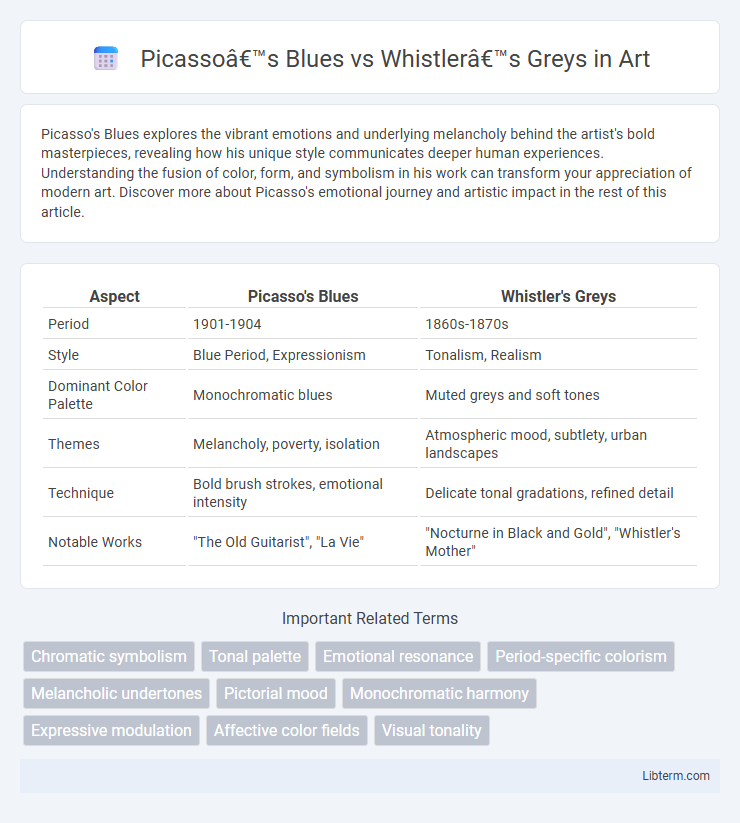Picasso's Blues explores the vibrant emotions and underlying melancholy behind the artist's bold masterpieces, revealing how his unique style communicates deeper human experiences. Understanding the fusion of color, form, and symbolism in his work can transform your appreciation of modern art. Discover more about Picasso's emotional journey and artistic impact in the rest of this article.
Table of Comparison
| Aspect | Picasso's Blues | Whistler's Greys |
|---|---|---|
| Period | 1901-1904 | 1860s-1870s |
| Style | Blue Period, Expressionism | Tonalism, Realism |
| Dominant Color Palette | Monochromatic blues | Muted greys and soft tones |
| Themes | Melancholy, poverty, isolation | Atmospheric mood, subtlety, urban landscapes |
| Technique | Bold brush strokes, emotional intensity | Delicate tonal gradations, refined detail |
| Notable Works | "The Old Guitarist", "La Vie" | "Nocturne in Black and Gold", "Whistler's Mother" |
Introduction: Contrasting Artistic Palettes
Picasso's Blues in his Blue Period evoke deep melancholy through monochromatic shades of blue, reflecting themes of poverty and human suffering. Whistler's Greys, exemplified in his Nocturnes series, utilize muted greys to convey atmospheric subtlety and quiet urban landscapes. These contrasting palettes highlight each artist's distinct emotional focus and stylistic approach to color symbolism.
Historical Context: Blue and Grey in Art Movements
Picasso's Blues emerged during the Blue Period (1901-1904), reflecting themes of melancholy and poverty influenced by Symbolism and Post-Impressionism. Whistler's Greys, prominent in his Nocturne series (1870s-1880s), embody tonal harmony aligned with Aestheticism and Tonalism, emphasizing mood over narrative. Both artists used blue and grey hues to convey emotional depth, yet Picasso's work engaged with personal and social malaise while Whistler pursued formal beauty and atmospheric subtlety.
Picasso’s Blues: Origins and Influences
Picasso's Blue Period, spanning 1901 to 1904, drew heavily from themes of poverty, isolation, and melancholy, influenced by his personal struggles and the suicide of his friend Carlos Casagemas. The extensive use of blue tones created a somber atmosphere that reflected the emotional depth of his subjects, linking to Symbolist and Modernist movements. This period marked a profound exploration of human suffering, contrasting with Whistler's Greys, which emphasized tonal harmony and aesthetic subtlety.
Whistler’s Greys: The Art of Subtlety
Whistler's Greys exemplify the art of subtlety through a restrained color palette dominated by nuanced shades of gray, emphasizing mood and atmosphere over bold expression. Unlike Picasso's Blues, which convey intense emotion through vivid blue tones, Whistler's Greys engage viewers with delicate tonal variations and refined brushwork, creating a contemplative and serene visual experience. This approach highlights Whistler's mastery in capturing quiet beauty and understated elegance within his compositions.
Emotional Resonance: Melancholy vs Serenity
Picasso's Blues evoke a profound melancholy through somber tones and expressive brushwork that channel deep emotional turmoil, reflecting themes of sadness and introspection. In contrast, Whistler's Greys convey serenity with muted, harmonious hues and soft contours that create a tranquil atmosphere, emphasizing calmness and contemplative stillness. Both palettes masterfully harness color to evoke distinct emotional resonances--melancholy in Picasso's work versus serenity in Whistler's compositions.
Techniques: Layering Blues and Blending Greys
Picasso's Blues exhibit masterful layering techniques, utilizing multiple translucent blue hues to create depth and emotional intensity that resonate throughout his Blue Period works. In contrast, Whistler's Greys employ delicate blending methods, seamlessly merging soft grey tones to evoke ethereal atmospheres and subtle tonal variations characteristic of his Nocturnes. Both artists demonstrate exceptional control over their palettes, with Picasso emphasizing bold, textured layers and Whistler focusing on smooth, harmonious transitions within monochromatic schemes.
Color Symbolism: Meaning Behind the Hues
Picasso's Blues in his Blue Period evoke feelings of melancholy, isolation, and introspection, symbolizing sorrow and human suffering through cool, muted tones. Whistler's Greys in his Nocturnes signify subtlety, calmness, and ambiguity, using a harmonious palette that blurs reality and mood to create a contemplative atmosphere. Both artists leverage their distinctive color symbolism to deepen emotional impact and convey complex psychological states.
Key Works: Signature Pieces of Both Artists
Picasso's Blues series, exemplified by "The Old Guitarist" (1903-1904), showcases a somber palette and introspective themes reflecting human suffering during his Blue Period. Whistler's Greys, epitomized by "Arrangement in Grey and Black No.1" (1871), also known as "Whistler's Mother," emphasizes tonal harmony and subtle gradations of grey to create a mood of quiet dignity. Both artists utilize color as a primary emotional and compositional tool, with Picasso's blues expressing melancholy and Whistler's greys conveying restraint and elegance.
Critical Reception: Then and Now
Picasso's Blues were initially met with skepticism due to their somber palette and emotional intensity, contrasting sharply with the more subtle tonalities favored by critics of the early 20th century. Whistler's Greys received praise for their delicate harmony and refined aesthetic, aligning closely with Victorian ideals and garnering widespread acclaim during his lifetime. Contemporary reviews increasingly recognize Picasso's Blues as pioneering in emotional depth and innovation, while Whistler's Greys are celebrated for their influence on tonal harmony and atmospheric composition.
Lasting Impact: Legacy in Modern Art
Picasso's Blues period introduced a profound emotional depth and monochromatic intensity that reshaped modern art's exploration of human suffering, influencing Expressionism and beyond. Whistler's Greys exemplified tonal harmony and subtlety, pioneering abstract aesthetics that anticipated Minimalism and influenced Impressionist tonal palettes. Both movements left enduring legacies by expanding the emotional and visual language of modern art, inspiring generations of artists to explore mood through color and tone.
Picasso’s Blues Infographic

 libterm.com
libterm.com